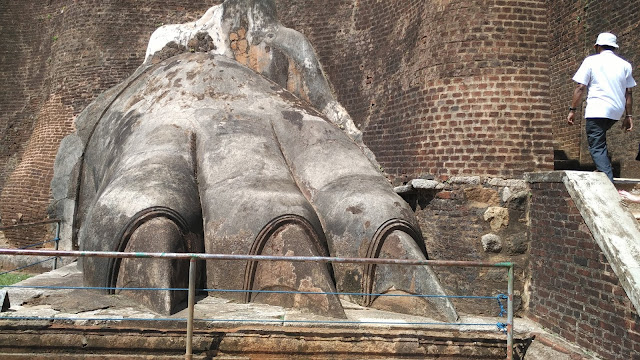-----
-published in The Hindu dated July 12th 2018
 |
| Sigiriya - The Rock Fortress |
Sigiriya – the
mansion in the sky - is an architectural marvel. Aptly named Lion Hill, the rocky citadel
rises up like a majestic lion, ascending to a lofty height of nearly 200 metres
from the surrounding plains. It has
rightly been considered as the 8th wonder of the world by the Sri
Lankans and is one of their most visited tourist attractions. The rocky
fortress and the adjoining garden complex is nearly 1600 years old, dating back
to the 5th Century AD.
Sigiriya is situated close to the village of Dambulla, which
is about 100 kms from Sri Lanka’s commercial capital, Kandy. An early start from Kandy will ensure that
one can reach the fortress and start the climb before it gets extremely
hot. As we approach this ancient piece
of marvel, we can only wonder at the sheer ingenuity of King Kashyapa who built
his palace atop the hill and created a small city for his people surrounding
the hill. Even in those ancient days,
the King could blend the natural beauty of the plateau with the architectural
splendour of his fortress. He also
deployed scientific methods for building gardens and underground reservoirs.
 |
| The Lion's Paw |
The story of King Kashyapa’s life is also very interesting
and is filled with intrigue and drama. He is born as the eldest son of the then
king Dhatusena. But Kashyapa is denied
his rights as the rightful heir to the throne as he is the illegitimate son –
born to the King’s concubine. His
step-brother, Mogallana claims the title of ‘yuva raja’ or ‘crown prince’ as
his mother is the royal queen of King Dhatusena, who also favours his younger
son to become the king.
Kashyapa resents this usurping of his entitlement, kills his
father and takes control of the kingdom.
Mogallana, fearing for his life, flees to India. Kashyapa then crowns himself as the King. But being worried that his brother may come
back to attack him, he decides to build his fortress and palace atop the huge
lion-like structured rock; thus, Sigiriya, the impregnable citadel is born.
From the top, it provides unhindered views of the surrounding plains.
 |
| While climbing up the fortress |
Today, we can climb several flights of steps, up the rock to
reach the top. Half way through, we get
to see the huge claws of a seated lion that King Kashyapa had got sculpted. The
upper body of the lion is no longer visible. His appreciation for the arts can be gauged
by the beautiful frescoes that cover the rock walls. Though these paintings of pretty damsels were
done around 460 AD, the natural colours remain intact and still retain their shine
despite the ravages of time. Higher
up the hill, on the rock surface, is the ’mirror wall’. Using a material found locally, King Kashyapa
got this ‘mirror’ installed – the rock surface was scoured and polished till it
resembled a mirror. It reflected the
image of the beautiful landscaped gardens, and ponds filled with aquatic
flowers that were maintained right below the hill. King Kashyapa employed engineering skills to
have an underground reservoir built that remained filled with water even during
the dry season. He ensured the
scientific use of rain water to provide water to his garden. A complex hydraulic system of canals, lakes,
bridges, fountains and surface/underground pumps was set up to irrigate the
gardens and the surrounding moat and ramparts.
These are functional even today.
 |
| At the base |
After the slow and arduous climb to the top, the view is
breath taking. We also get to see the
ruins of the erstwhile palace constructions – the royal throne, the king and
queen’s apartments, ponds. King Kashyapa
ruled from his secure palace for nearly 22 years till 495AD. His deep-rooted fear that his step-brother
would return with an army and wage a war became a reality. Mogallana attacked the seemingly impregnable
Sigiriya Fort, killed King Kashyapa and took over the reins.









